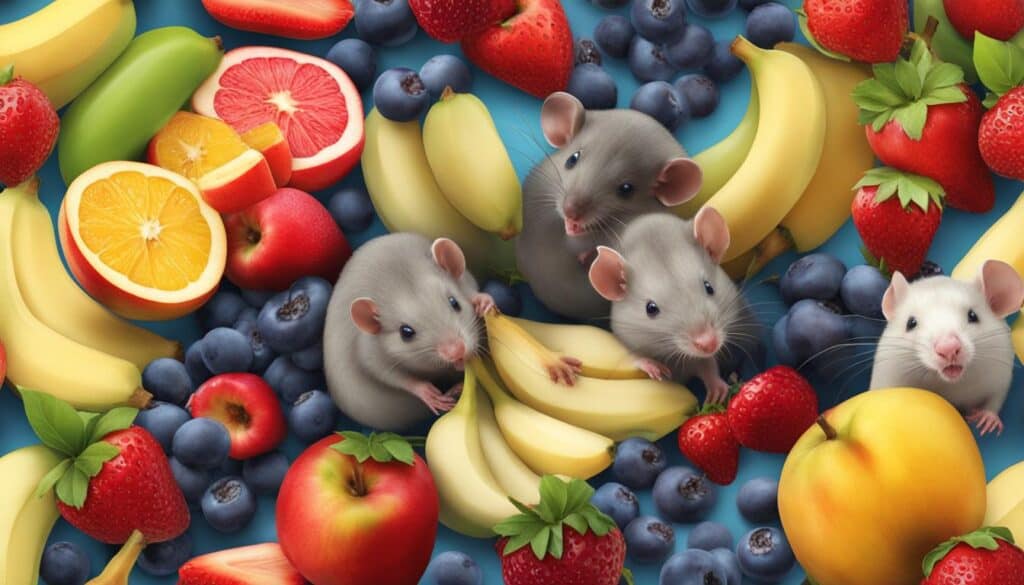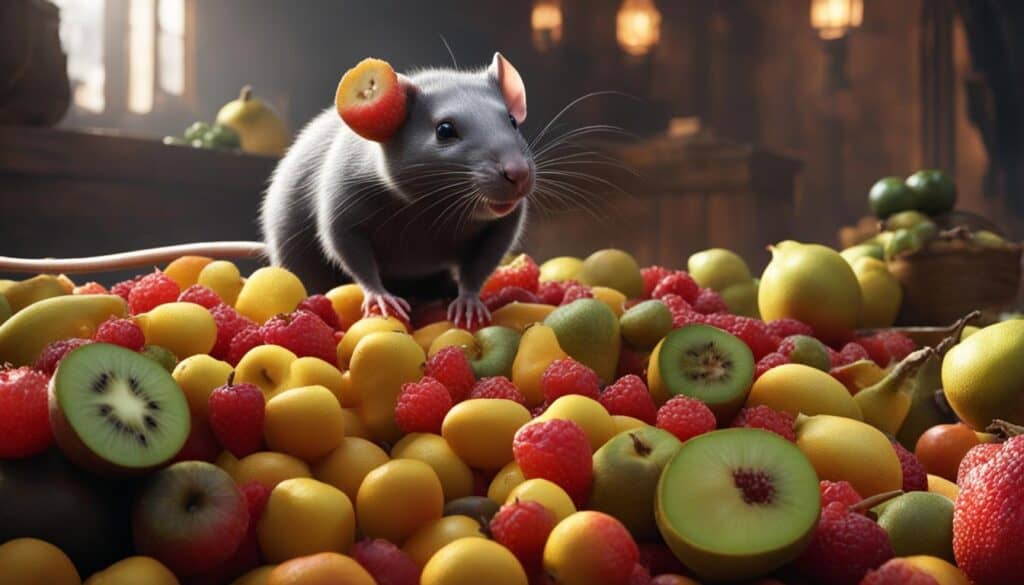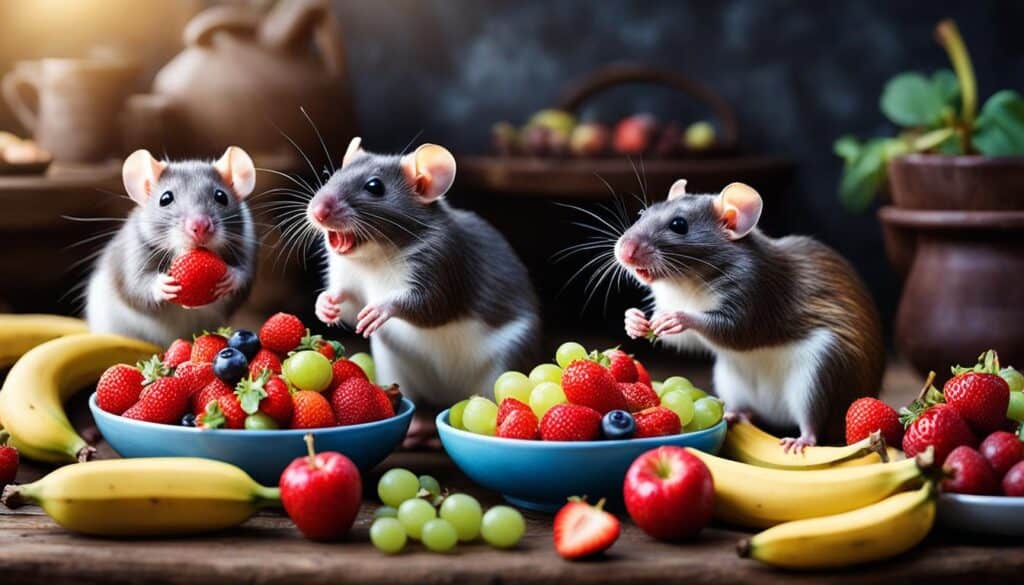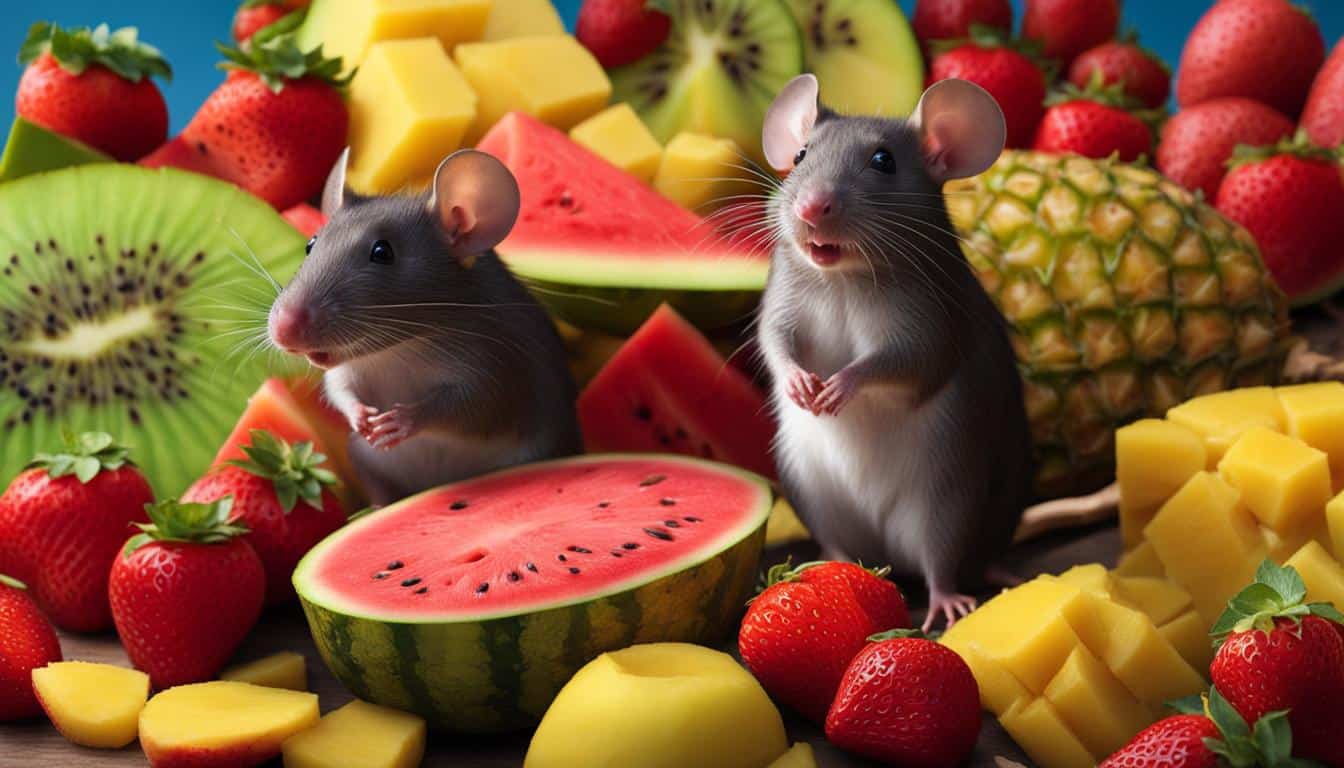Giving your pet rat a balanced and nutritious diet is essential for their overall health and well-being. As omnivores, rats can enjoy a variety of fruits to supplement their diet. Including fruits in their diet provides important vitamins and minerals, as well as some natural sweetness for their taste buds.
When choosing fruits for your rat, it’s important to focus on safe options that won’t harm their health. In this article, I will share my top picks of fruits that are considered safe for rats to eat. Remember, moderation is key, and fruits should make up about 10 percent of your rat’s calorie intake.
Before we dive into the list of safe fruits, it’s important to note that every rat is different, and individual dietary needs may vary. Always consult with a veterinarian experienced in rat care for guidance on your rat’s specific dietary requirements.
Key Takeaways:
- Offering a variety of safe fruits can supplement your rat’s diet and provide important vitamins and minerals.
- Fruits should make up about 10 percent of your rat’s calorie intake.
- Consult with a veterinarian experienced in rat care for personalized advice on your rat’s dietary needs.
- Remember to feed fruits in moderation.
- Experiment with different fruits to see which ones your rat enjoys the most.
Vegetables for a Healthy Rat Diet
In addition to fruits, rats can also benefit from consuming vegetables. Including a variety of vegetables in a rat’s diet ensures they receive essential nutrients for optimal health. While fruits provide natural sugars and vitamins, vegetables offer additional vitamins, minerals, and fiber.
When choosing vegetables for your pet rat, opt for dark, green leafy vegetables as they are particularly nutritious. These include:
- Broccoli
- Cucumber
- Zucchini
- Asparagus
Other vegetables that can be offered in small amounts include:
- Pumpkin
- Squash
- Carrot
- Potato
- Rutabaga
- Parsnip
Fresh herbs like basil, fennel, and parsley can also be included in a rat’s diet to add flavor and provide additional health benefits. Additionally, rats can eat alfalfa sprouts, cauliflower, and store-bought mushrooms as part of their vegetable intake.
Remember to always provide fresh, clean vegetables and remove any uneaten portions promptly to prevent spoilage and contamination. It’s important to note that a rat’s diet should consist of a balance of various foods, including fruits, vegetables, and proteins, to ensure their nutritional needs are met.
Why Dark, Green Leafy Vegetables?
Dark, green leafy vegetables are highly nutritious, containing vitamins A, C, and K, as well as minerals like calcium, iron, and folate. These vegetables are low in calories and high in fiber, making them an excellent addition to a rat’s diet. Fiber helps promote digestive health and aids in preventing certain health issues, such as constipation. Including these vegetables in your rat’s diet helps create a well-rounded and healthy eating plan.
Fruits and Veggies to Be Fed With Caution
While most fruits and vegetables are safe for rats, there are some that should be fed with caution. It’s important to consider the potential risks associated with certain fruits and vegetables to ensure the health and well-being of your pet rat.
Fruits to Be Cautious With for Fruit Rats
Certain fruits may have specific considerations when it comes to feeding them to fruit rats. While oranges, grapefruits, and lemons are generally safe for female rats, some rat owners choose to avoid feeding these citrus fruits to males due to a potential link to cancer. Similarly, papaya and mango are fruits that may be avoided for male rats for the same reason. It’s always a good idea to monitor your rat’s health and consult with a veterinarian for personalized advice.
Vegetables to Avoid for Fruit Rats
When it comes to vegetables, there are a few that should be avoided or prepared with caution for fruit rats. Raw sweet potatoes, cabbage, and Brussels sprouts can be toxic to rats and should be cooked thoroughly before offering. This helps to eliminate any potential harmful substances and make them safe for consumption. Additionally, corn is generally considered safe for rats to eat, but it is typically included in rat pellets and doesn’t add variety to their diet.
Safe and Cautionary Fruits and Vegetables for Fruit Rats
For a quick reference, here is a table outlining some safe and cautionary fruits and vegetables for fruit rats:
| Fruits | Vegetables |
|---|---|
| Strawberries | Broccoli |
| Blueberries | Cucumber |
| Blackberries | Zucchini |
| Raspberries | Asparagus |
| Pomegranate | Pumpkin |
| Raisins | Squash |
| Blackcurrants | Carrot |
| Melon | Potato |
| Seedless grapes | Rutabaga |
| Apples | Parsnip |
| Pears | |
| Nectarines | |
| Kiwi | |
| Peaches | |
| Banana | |
| Avocado |
Remember, it’s crucial to provide a balanced and varied diet for your pet rat. While certain fruits and vegetables should be fed with caution, there are still many options available to ensure their nutritional needs are met. Always consult with a veterinarian for specific advice regarding your rat’s diet.
Recommended Ratio of Fruits and Veggies for Rats
When it comes to feeding fruit rats, finding the right balance of fruits and vegetables is essential for their overall health and well-being. While there may be varying opinions among rat fanciers, a general recommendation is to include fruits and vegetables as 10 to 20 percent of a rat’s total food intake by weight. This ensures that your furry friend gets the necessary nutrients from their natural diet.
Experimentation may be needed to find the best ratio for your individual rats, as each rat may have different preferences and nutritional needs. It’s always beneficial to consult with a veterinarian experienced in rat care for guidance on your rat’s specific dietary requirements.
| Fruits | Vegetables |
|---|---|
| Strawberries | Broccoli |
| Blueberries | Cucumber |
| Blackberries | Zucchini |
| Raspberries | Asparagus |
| Pomegranate | Pumpkin |
| Raisins | Squash |
| Blackcurrants | Carrot |
| Melon | Potato |
| Seedless grapes | Rutabaga |
| Apples | Parsnip |
| Pears | Fresh herbs (basil, fennel, parsley) |
| Nectarines | Alfalfa sprouts |
| Kiwi | Cauliflower |
| Peaches | Store-bought mushrooms |
| Banana | |
| Avocado |
The Best Rat Diet: Fruits, Veggies, and Meats
Rats are omnivores, which means they should consume a balanced diet that includes not only fruits and vegetables but also meats. Along with fresh fruits and vegetables, rats can also benefit from consuming rat pellets or rat cube food that has a protein content of at least 16% and a fat content of 4-5%. Lean cooked meats such as liver can also be offered as occasional treats. It is important to provide a well-rounded diet to ensure the overall health and nutrition of pet rats.

To understand the significance of including meats in a rat’s diet, let’s take a look at the nutrients they provide:
| Nutrient | Benefits |
|---|---|
| Protein | Essential for growth, repair, and maintenance of body tissues |
| Fat | Provides energy and aids in the absorption of fat-soluble vitamins |
| Vitamin B12 | Crucial for red blood cell production and maintaining a healthy nervous system |
| Iron | Supports the production of red blood cells and aids in oxygen transport |
| Zinc | Plays a role in immune function, growth, and wound healing |
| Omega-3 Fatty Acids | Helps reduce inflammation and supports cardiovascular health |
Including meats in a rat’s diet ensures they receive essential nutrients for overall health and well-being. However, it’s important to note that meats should be offered in moderation and cooked thoroughly to eliminate any potential bacteria or parasites.
In addition to fresh fruits, vegetables, and meats, rat owners can also provide rat-safe multi-vitamin supplements to ensure their pets are getting all the necessary nutrients.
Proper nutrition is crucial for the well-being of our pet rats. A balanced diet that includes a variety of fruits, vegetables, and meats ensures their overall health and happiness. Remember, just like humans, rats thrive on a diverse and nutritious diet.
Foods to Avoid for Pet Rats
When it comes to feeding pet rats, it’s important to be aware of certain foods that should be avoided. While rats can enjoy a wide variety of fruits and vegetables, there are specific items that can be harmful to their health. To ensure the well-being of your furry friend, here are some foods you should keep away from your pet rat’s diet:
Foods to Avoid:
- Chocolate: While our taste buds may crave it, chocolate is toxic to rats and should never be given to them. Even small amounts can cause serious health problems for these little critters.
- Caffeine: Just like in humans, caffeine can have adverse effects on rats. It can cause an increase in heart rate, tremors, and even lead to seizures in severe cases.
- Raw Beans: Raw beans contain substances that are toxic to rats. Soaking, boiling, or cooking beans thoroughly can remove these harmful compounds and make them safe for consumption.
- Raw Sweet Potatoes: Raw sweet potatoes have a natural enzyme that can be harmful to rats. However, cooked sweet potatoes are safe and can be enjoyed as part of a balanced diet.
- Cabbage and Brussels Sprouts: These vegetables, when consumed raw, can cause gas and digestive discomfort for rats. It’s best to cook them before offering them to your pet.
- Green Potatoes: Green potatoes contain a toxic substance called solanine, which can be harmful to rats. Always ensure that the potatoes you offer are fresh and have not turned green.
- Sweet, Sugary Treats, and Junk Food: These items may be tempting, but they can lead to obesity and a range of health problems in rats. Stick to healthy, natural foods instead.
Additionally, it’s important to avoid feeding rats foods that contain d-limonene. This compound can be found in lemon peels, orange peels, mangoes, black pepper, and nutmeg. While the exact effects on rats are not fully understood, there are concerns that d-limonene may contribute to certain health issues, particularly in male rats.
Lastly, be cautious when it comes to feeding rats wild insects. Insects from the wild can carry parasites or have been exposed to pesticides, both of which can be harmful to rats. It’s best to provide commercially bred insects as a safe and nutritious alternative.
Remember, a healthy diet is crucial for the well-being of your pet rat. By avoiding these foods and providing a balanced and nutritious diet, you can ensure that your furry friend stays happy and healthy.

Understanding what foods to avoid for pet rats is crucial to their well-being and overall health. By being mindful of their diet, you can help them live a long and happy life.
Tips for Feeding and Enriching Your Rat’s Diet
Feeding fruit rats can be an exciting and rewarding experience. To ensure they have a healthy and natural diet, here are some tips to enhance their feeding routine:
- Hide Treats and Pellets: Instead of simply placing treats and pellets in a food bowl, make feeding time more stimulating by hiding them in paper cups or toilet paper tubes. This encourages your rat to forage and engage their natural instincts.
- Scatter Treats: Rather than offering treats in one centralized location, try scattering them around the cage. This provides mental and physical stimulation as your rat actively searches and explores their environment.
- Interactive Toys: Consider purchasing interactive toys that require rats to solve simple puzzles to access their treats. These toys provide mental stimulation and keep rats entertained and engaged.
- Chewable Items: Rats have a natural urge to chew, which helps maintain healthy teeth. Provide them with items like cardboard, coconut shells, or soft wood to satisfy their chewing needs while promoting dental health.
By implementing these tips into your rat’s feeding routine, you can provide them with a rich and fulfilling diet that mimics their natural foraging behavior.

Maintaining a Healthy Weight for Pet Rats
Obesity can be a common issue for pet rats, so it’s important to help them maintain a healthy weight. Rats that live in cages are particularly prone to becoming overweight. To prevent obesity, incorporate activities that encourage exercise, such as providing multi-level cages and supervised time outside of the cage to run around. It is also important to monitor treat consumption and provide the appropriate amount of food for a rat’s size to avoid overfeeding.
Tips for Maintaining a Healthy Weight:
- Choose a multi-level cage or consider adding platforms to encourage climbing and physical activity.
- Allow rats supervised time outside of the cage to explore and play.
- Provide toys and tunnels to stimulate exercise and mental enrichment.
- Monitor treat consumption and limit the number of high-calorie treats.
- Ensure the rat’s daily diet consists of a balanced mix of fruits, vegetables, and rat pellets.
- Consult with a veterinarian to determine the appropriate amount of food for your rat’s size and activity level.
By implementing these strategies, you can help your pet rat maintain a healthy weight and overall well-being.
| Activity | Benefit |
|---|---|
| Multi-level cage | Promotes climbing and increases physical activity. |
| Supervised playtime outside the cage | Allows for exploration and exercise. |
| Toys and tunnels | Stimulates exercise and mental enrichment. |
| Monitor treat consumption | Limits intake of high-calorie treats. |
| Balanced diet | Provides essential nutrients without excessive calories. |
| Veterinary guidance | Ensures appropriate food portions based on rat’s size and activity level. |

By implementing these strategies and consistently monitoring your pet rat’s weight and eating habits, you can ensure they lead a healthy and active life.
Conclusion
In conclusion, a balanced and nutritious diet is crucial for the health and well-being of pet rats. Offering a variety of safe fruits and vegetables, such as strawberries, blueberries, broccoli, and cucumber, can provide essential vitamins and minerals to support their overall nutrition. Alongside fruits and veggies, incorporating rat pellets or rat cube food with a proper protein and fat content ensures they receive the necessary nutrients for their growth and development.
It is important to note that certain foods should be avoided as they can be toxic or unhealthy for rats. Citrus fruits like oranges and grapefruits, as well as foods with d-limonene, should be fed with caution or avoided altogether. Additionally, providing mental and physical stimulation through feeding activities, like hiding treats, can keep rats engaged and prevent boredom. Environmental enrichment, such as providing chew toys and multi-level cages, further promotes their well-being.
While this guide provides a general overview, consulting with a veterinarian experienced in rat care is essential for tailored advice on your rat’s specific dietary needs. By following these guidelines and ensuring a well-rounded diet, you can provide your pet rat with a safe and wholesome food experience, contributing to their overall health and happiness.
FAQ
What are some safe fruits for fruit rats?
Safe fruits for fruit rats include strawberries, blueberries, blackberries, raspberries, pomegranate, raisins, blackcurrants, melon, seedless grapes, apples, pears, nectarines, kiwi, peaches, banana, and avocado. These fruits can be offered as a treat a few times per week.
What vegetables should I include in a healthy rat diet?
Dark, green leafy vegetables like broccoli, cucumber, zucchini, and asparagus are excellent choices. Pumpkin, squash, carrot, potato, rutabaga, and parsnip can be offered in small amounts as well. Fresh herbs like basil, fennel, and parsley can also be included in a rat’s diet. Additionally, rats can eat alfalfa sprouts, cauliflower, and store-bought mushrooms.
Which fruits and vegetables should I be cautious with for fruit rats?
Citrus fruits like oranges, grapefruits, and lemons are generally safe for female rats, but some rat owners avoid feeding them to males due to a potential link to cancer. Papaya and mango are also fruits that some rat owners choose to avoid for the same reason. Raw sweet potatoes, cabbage, and Brussels sprouts can be toxic to rats and should be cooked before offering.
What is the recommended ratio of fruits and vegetables for rats?
It is generally recommended that fruits and vegetables make up 10 to 20 percent of a rat’s total food intake by weight. Rat owners may need to experiment to find the best ratio for their individual rats. It is always advisable to consult with a veterinarian experienced in rat care for guidance on a rat’s specific dietary needs.
What should be included in the best rat diet?
Along with fresh fruits and vegetables, rats can also benefit from consuming rat pellets or rat cube food that has a protein content of at least 16% and a fat content of 4-5%. Lean cooked meats such as liver can also be offered as occasional treats. It is important to provide a well-rounded diet to ensure the overall health and nutrition of pet rats.
What foods should I avoid feeding my pet rats?
Foods that should not be given to rats include chocolate, caffeine, raw beans, raw sweet potatoes, cabbage, Brussels sprouts, green potatoes, sweet, sugary treats, and junk food. Rats should also not be fed foods with d-limonene, such as lemon peels, orange peels, mangoes, black pepper, and nutmeg, as these may be linked to certain health issues in male rats. Additionally, it is important to avoid feeding rats wild insects due to potential parasites and pesticides.
How can I enrich and stimulate my rat’s diet?
To make feeding more stimulating for your rat, try hiding treats or pellets in paper cups or toilet paper tubes, and scatter treats around the cage instead of placing them in a food bowl. You can also consider purchasing interactive toys that require rats to solve simple puzzles to access their treats. Additionally, providing them with items like cardboard, coconut shells, or soft wood can help promote healthy teeth and prevent boredom.
How can I help my pet rat maintain a healthy weight?
To prevent obesity, incorporate activities that encourage exercise, such as providing multi-level cages and supervised time outside of the cage to run around. It is also important to monitor treat consumption and provide the appropriate amount of food for a rat’s size to avoid overfeeding.





Leave a Reply